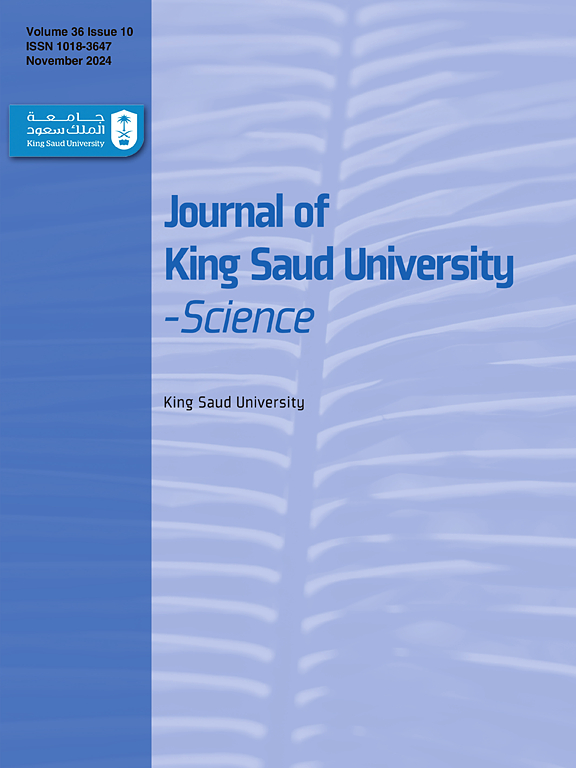Therapeutic potential of Chemogenic Iron oxide Nanoparticles, its antioxidant and anti-Inflammatory effects with reduction of ankle joint swelling in BALB/c mice
IF 3.6
3区 综合性期刊
Q1 MULTIDISCIPLINARY SCIENCES
引用次数: 0
Abstract
Background: Gout is a form of inflammatory arthritis caused by excessive deposition of uric acid in the body and joints. Prolonged administration of uric acid lowering drugs have multiple side effects. Objectives: To investigate the antioxidant and anti-gout properties of iron oxide nanoparticles in hyperuricemic gouty mice. Methodology: Sol-Gel precipitation technique was used for chemogenesis of Iron oxide nanoparticles by using Ferrous Chloride (FeCl2) and Ferric chloride (FeCl3). Characterization was carried out by X-ray diffraction, SQUID magnetization, scanning electron microscopy(SEM) and energy-dispersive X-ray spectroscopy(EDX). Monosodium Urate crystals (MSUC) induced gout into the ankle joint of the mice. Iron oxide nanoparticles were orally administrated to the mice. To study the impact of Iron oxide nanoparticles biochemical analysis like total protein, antioxidant activity, and ankle diameter were conducted. Results: Results showed that oral administration of iron oxide nanoparticles had a beneficiary impact on gouty mice. The antioxidant activity were significantly improved by increasing levels of thiobarbituric acid reactive substance and reactive oxygen species in treated group with 250 mg/kg of body weight of iron oxide nanoparticles. Ankle diameter and levels of total protein were also reduced in treated groups. Conclusion: Current research indicates that Iron oxide nanoparticles have antioxidant as well as anti-gout effects in gouty mice. These results provide credence to the possibility of using Iron oxide nanoparticles as a gout alternative treatment. The potential therapeutic uses of iron oxide nanoparticles in human patients require more investigation.
致化学氧化铁纳米颗粒的治疗潜力及其抗氧化和抗炎作用与减轻BALB/c小鼠踝关节肿胀
背景:痛风是一种炎症性关节炎的形式,引起过多的尿酸沉积在身体和关节。长期服用降尿酸药物有多种副作用。目的:研究氧化铁纳米颗粒对高尿酸血症性痛风小鼠的抗氧化和抗痛风作用。方法:采用溶胶-凝胶沉淀法,采用氯化亚铁(FeCl2)和氯化铁(FeCl3)制备氧化铁纳米颗粒。通过x射线衍射、SQUID磁化、扫描电镜(SEM)和能量色散x射线能谱(EDX)对其进行了表征。尿酸钠晶体(MSUC)诱导小鼠踝关节痛风。小鼠口服氧化铁纳米颗粒。为了研究氧化铁纳米颗粒对小鼠总蛋白、抗氧化活性、踝部直径等生化指标的影响。结果:结果表明,口服氧化铁纳米颗粒对痛风小鼠有有益作用。在250 mg/kg体重的氧化铁纳米颗粒处理组中,通过增加硫代巴比妥酸活性物质和活性氧水平,显著提高了抗氧化活性。治疗组的踝关节直径和总蛋白水平也有所降低。结论:目前研究表明氧化铁纳米颗粒对痛风小鼠具有抗氧化和抗痛风作用。这些结果为使用氧化铁纳米颗粒作为痛风替代治疗的可能性提供了证据。氧化铁纳米颗粒在人类患者中的潜在治疗用途需要更多的研究。
本文章由计算机程序翻译,如有差异,请以英文原文为准。
求助全文
约1分钟内获得全文
求助全文
来源期刊

Journal of King Saud University - Science
Multidisciplinary-Multidisciplinary
CiteScore
7.20
自引率
2.60%
发文量
642
审稿时长
49 days
期刊介绍:
Journal of King Saud University – Science is an official refereed publication of King Saud University and the publishing services is provided by Elsevier. It publishes peer-reviewed research articles in the fields of physics, astronomy, mathematics, statistics, chemistry, biochemistry, earth sciences, life and environmental sciences on the basis of scientific originality and interdisciplinary interest. It is devoted primarily to research papers but short communications, reviews and book reviews are also included. The editorial board and associated editors, composed of prominent scientists from around the world, are representative of the disciplines covered by the journal.
 求助内容:
求助内容: 应助结果提醒方式:
应助结果提醒方式:


